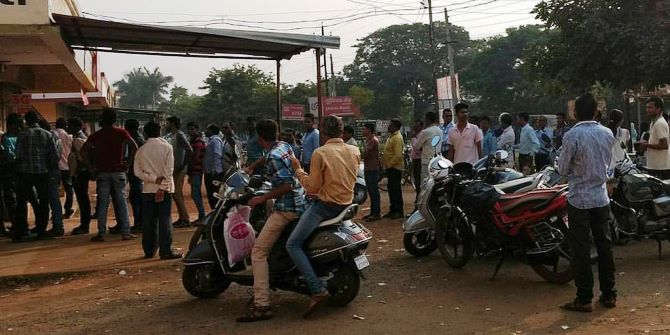 Maitreesh Ghatak reflects on the current economic scenario following demonetisation, its shifting stated objectives and how this was reflected in the Union Budget. He writes that the expanded budget allocation to MGNREGA in particlar is reflective of the increased uptake by workers hit by the Government’s notes ban.
Maitreesh Ghatak reflects on the current economic scenario following demonetisation, its shifting stated objectives and how this was reflected in the Union Budget. He writes that the expanded budget allocation to MGNREGA in particlar is reflective of the increased uptake by workers hit by the Government’s notes ban.
Whether demonetisation will eliminate the shadow economy remains unclear but it has definitely cast a long shadow on the government’s budget and the discussions surrounding it.
In his budget speech this week, the Finance Minister Arun Jaitley defended the demonetisation policy of the government as a bold measure against tax evasion, claiming that it will lead to a GDP that is “bigger, cleaner, and real”.
Yesterday, for the third year in a row, Chief Economic Advisor Arvind Subramanian produced an impressive Economic Survey document. It provides a refreshing break from the narrative coming from the ‘all-izz-well’ corner of economic commentators who feel critics are just cockeyed naysayers. Also, unlike most government documents, far from being yawn-inspiring, it is actually interesting to read – that in itself is an achievement. After all, when was the last time a government document on a dry topic like monetary policy began with a quote like “Taka mati, mati taka” (“Money is like soil, soil is like money”) by Sri Ramakrishna Paramhamsa!
Now, given the current economic scenario following demonetisation, a more appropriate Sri Ramakrishna quote might have been the more reassuring “Bhoy ki re pagol, ami to achhi! (Don’t be afraid, crazy child, I am here)”. However, given the virtual absence of the Chief Economic Advisor and the Governor of the RBI from the public domain ever since the misguided demonetisation policy was unleashed on the economy, the choice of the quotation may indeed be apt.
As many including I have argued, the demonetisation policy that indeed converted 86% of currency notes into soil, was deeply flawed in theory, and its implementation and the many flip-flops in the rules is a textbook example of administrative bungling. The stated objectives have shifted from a one-time tax on black wealth to curbing counterfeit money to cutting off finance for terrorists to accelerating the move to a digital economy to, as of yesterday, making real estate cheaper. None of this holds up to scrutiny – almost all the old notes have been deposited back in banks, and the new notes have proved to be as popular with counterfeiters as well as terrorists.
And to say such a policy is going to accelerate the move to a digital economy is like saying if we close down all retail shops from tomorrow, everyone is going to order online. Yes, that may be the way of the future, and may be true of those who are on the right side of the digital divide, but as of now, not more than a quarter of Indians have smartphones and a similar percentage have access to the internet.
The Economic Survey is right in saying that real estate prices may have fallen as a result of this policy. But this was not a stated objective; and even if it was the objective, it stretches credulity to make the case that to achieve this, the best policy is to withdraw 86% of the country’s money supply! One might as well be talking about reducing the spread of skin-disease given how dirty some of the old notes were!
Talking about the dirtiness of old notes, the Economic Survey does come up with an interesting, though admittedly imperfect, way of measuring the extent of black money. They use data on “soil rates”, that is, the rate at which notes are considered to be too damaged to use and have been returned to the central bank. Using the logic that if the notes were actually being used for transactions, as opposed to being stored as wealth, they would probably be getting dirty or damaged quicker, from the data on soil rates they estimate the amount of cash not used for transactions, and hence potentially black, to be 3 lakh crore, which represents about 2 percent of GDP.
Even if this estimate is true, given that almost all the old notes have been returned, contrary to what the government initially expected, was it worth inflicting a negative shock to the economy that pushed the growth rate down? The Economic Survey estimates the short-term of impact of this policy in terms of a fall in the growth rate of real GDP to be a quarter to a half percentage point, while the IMF estimates this to be a one percentage point drop. Moreover, these are likely to be significant underestimates. Field reports suggest that the extent of decrease in wholesale trade in the informal sector is to the tune of 20-30%, and the reason it is not captured in the projected growth rate for 2016-17 of 6.5% is because the unorganised sector data is not directly captured in the calculation, as the report itself acknowledges. Rather, this sector’s contribution is assumed to be in proportion to that in the organised sector, and yet following demonetisation, the growth rates of the two sectors are no longer linked.
It is true that the Indian economy will recover in the medium run, as the Finance Minister’s speech and the report suggests. Major economies like that of India do recover after shocks. After all, even the great US recession that started in the early months of 2008 officially ended in the second quarter of 2009. The question remains, was it worth it?
This debacle did more than earn the dubious distinction of the biggest policy-induced recession in history. We should not forget the direct costs of this policy in terms of hardship and pushing the poorer sections in the informal sector over the edge. By all accounts, the informal sector – which is normally the most cash-reliant part of the economy – has been particularly hard-hit.
All discussions of one or a half percentage point’s temporary dip in the growth rate seem to ignore a very basic point: in a highly unequal economy, even if the incomes of the poorer sections go down by a non-negligible percentage, the reduction in overall national income will be minor if the incomes of the rich are not affected very much. Consider an example: suppose there are 90 individuals earning Rs. 1 and 10 individuals earning Rs. 100 each, which gives a total income of Rs. 1,090. If the income of the poor goes down by 20%, but the income of the rich is unchanged, overall income will go down by only 1.6%. Therefore, statements like “It’s only a percentage point in the growth rate” or “the economy will surely recover” offer little comfort to those informal sector workers who had to head back to their villages because of the job losses caused by demonetisation.
And the irony is that while the Modi government has treated MGNREGA with some disdain in the past, it is MGNREGA that has come to the rescue of many of the unemployed informal sector workers who went back to their villages to look for work. Apparently, the uptake in MGNREGA has gone up significantly, the only upward trend in a season where most economic indicators have pointed southwards. No wonder, then, the stated budget allocation to MGNREGA increased to a record Rs. 48,000 crore for 2017-18, from Rs. 38,500 crore in 2016-17. This appears to be a large increase even in real terms, although questions have already cropped up about the true extent of the increase, with some arguing most of the increase has already taken place as a result of increased demand after demonetisation. May be like Munnabhai, the Finance Minister had visions of Gandhiji prior to the budget. May be it is the forthcoming elections in UP. Or maybe it is the PM’s indirect way of acknowledging the failure of the demonetisation policy, since he earlier described MGNREGA as a symbol of the failure of the Nehru-Gandhi model. Whatever the reason, this is an act of Gandhigiri that should be praised.
Cover image: A worksite supervisor collects her MGNREGA earnings in Lalitpur district, Uttar Pradesh. Credit: UN Women/Gaganjit Singh CC BY-NC-ND 2.0
This article originally appeared on 1 February 2017 on NDTV Opinion and is reposted with the author’s permission. It gives the views of the author, and not the position of the South Asia @ LSE blog, nor of the London School of Economics. Please read our comments policy before posting.
About the Author

Maitreesh Ghatak is Professor of Economics at LSE, where he is Deputy Head of Department for Research. He is Lead Academic on the IGC India-Bihar country team and Economic Organisation and Public Policy Programme Director at STICERD.








Yes right ,the impact of demontisation is hardly considered from informal sector. Govt has realised the rising the allocation to Mnerga might infuse some purchasing power in the hands of the people from informal sector.one thing is sure demontisation didn’t yield the expected result .